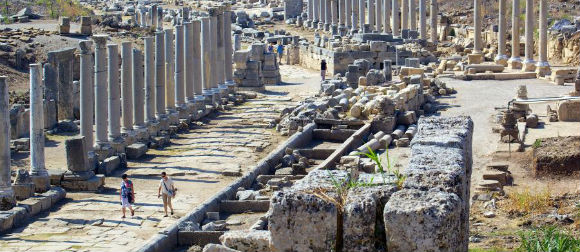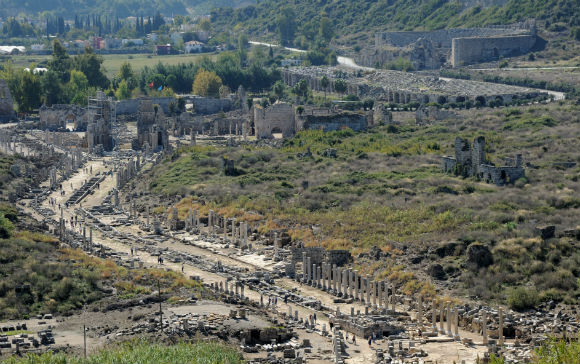The most impressive ruins of the Pamphylian coast are at Perge, at about 15 km east of Antalya. Perge was originally founded by the Hittites around 1500 BC. and was known as Parha. It was a successful trading centre near the Aksu (ancient Kestros or Cestrus) river when Alexander the Great arrived in 333 BC. He was welcomed in by the inhabitants and used Perge as base for his Anatolian campaigns. Alexander was followed by the Seleucids under whom the city prospered and Perge’s most celebrated inhabitant, the mathematician Apollonius from Perge lived and worked. Apollonius was a pupil of Archimedes and wrote a series of eight books on geometry. In 188 BC Perge became part of the Roman Empire during which the city flourished. Most of the surviving buildings date from this period.In 46 AD St. Paul started his journey in Perge (biblical Perga) and preached his first sermon here. Perge gradually declined during the Byzantine period, as the Aksu river silted, but remained inhabited until Selçuk times after which it became abandoned.
A visit to Perge starts by entering the archeological site through the Roman Gate, built during the reign of Septimius Severus (193-211 AD). Proceeding through the gate, to the right is the Agora or market place. This structure of 75 x 75 m dates back from the 2nd century AD. The center courtyard and shops were surrounded by a wide stoa, a covered walkway. The floor of the stoa and shops was made of colored mosaics. The agora was not only the centre of Perge’s trade, but was also a place for meetings as well as a forum for political, social, and philosophical discussions. The next building is the Hellenistic city gate that dates back to the 3rd century BC. This is certainly the most imposing building of the city and was cleverly designed to protect the city with its twin towers and its horseshoe-shaped courtyard at the back. It is thought that the towers had three floors and were crowned by a conical roof. In the year 121 AD, the horseshoe-shaped courtyard was rededesigned as a courtyard of honor. Behind the courtyard stood a triple arch. Around the arch there are about dozen inscriptions connected with Plancia Magna who lived in the 2nd century AD. She was the daughter of the governor, a priestess of Artemis Pergaia (Diana) and a benefactress to the city. Plancia Magna had the arch decorated with the statues of the emperors and their relatives.
After passing through the Hellenistic Gate and courtyard, one enters a broad, marble-paved double-colonnaded street measuring 300 meters in length that extends from the main gate to the acropolis. The street is 20 m wide and is divided in two by a 2 meter wide water channel running down the middle. At the end of the colonnaded street is the Nymphaeum, a triumphal fountain from where a stream flowed down into the water channel. The nymphaeum or nymphaion is an ornamental semicircular structure and dates from the reign of Emperor Hadrian (130-150 AD). A statue of a river god Kestros was located in the center of this huge fountain. Behind the nymphaeum is the acropolis with some remains of the Byzantine period. To the west of the nymphaeum are the remains of a palaestra dating from 50 AD and dedicated to the Emperor Cladius (41-54 AD).
Returning back to the entrance, there are the excavated Roman baths located southwest to the agora. Out of the site proper, is the horsehsoe-shaped stadium, the largest in Asia Minor, measuring 234 m by 34 m. The stadium had a seating capacity of 12,000 people supported by massive barrel-vaulted constructions. Just beyond the site entrance is also the theatre, which is of the Greco-Roman type and could seat 15,000 people. Unfortunately, it is for some time under reconstruction and unfortunately closed to visitors.
Perge,



This is nice, but there are so many others that are outstanding that it doesn't compare well. Worth seeing – but others are better.
The tickets are a quite reasonable 15TL and the site is reasonably well preserved. Some areas are closed for further excavation (most notably the theater area), but the rest is well presented and quite well restored. There are a lot of pieces strewn about, seemingly waiting to be better presented or catalogued, but they do not impede the viewing of…
We visited the ruins of Perge on January 23rd as part of a Best of Turkey tour. The visit was enhanced by the information provided by our guide, who recounted the attractions of the city. We were delighted to learn that St. Paul preached on this city, and the location was among the ruins that we visited.
The temperature was…
We saw many ruins on our short tour of Turkey and these were by far the best and the most well preserved
The sheer scale of Perge (and that's just what's been excavated so far) puts most of the ruins you'd see in Greece or Italy to shame. Second only to Ephesus in my view. I'd recommend going with a guide — there's so much there that needs explaining.
I was very excited to visit Perge. A guide is essential to explain the Hellenistic and Roman remains. Some signage around the site with some background would have been helpful, and there is clearly a great deal of conservation work to be done.It tends not to be year round conservation as they depend on university staff and they are finance…
Brilliant!! a must, what a privilege to be able to walk around and touch, and not to be behind a rope a 1/4 of a mile away!!
We booked this through a TUI excursion rep that came to our hotel. We like using the TUI excursions because they did not stop at fur, leather and jewlery shops; it was all about touring the areas you paid to see. Lunch was included and made for a very nice day. Bus was large and air conditioned.
I cannot compare it to Aspendos as I did not visit that site. However, Perge exceeded all of my family's expectations. We spent a good half-day walking around the expansive site, amazed at every crevace of this Roman city.
If you only have the time to visit a single Roman ruin, I don't think that you'd be disappointed to make…
Its easy to get to by bus from the otogar. Get a bus to Aksu then its a 10 min walk. The amphitheatre was closed for conservation but looked great as did the stadium. The two towers at the entrance are really spectacular. The baths are very well preserved. Its quite a big site and when we went we largely…